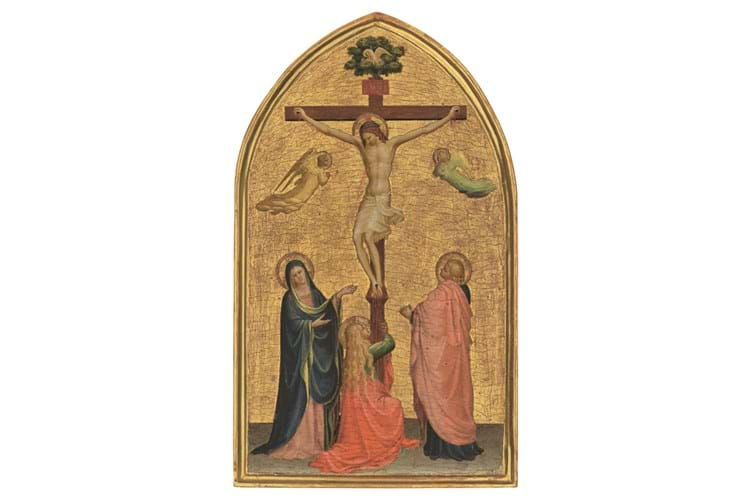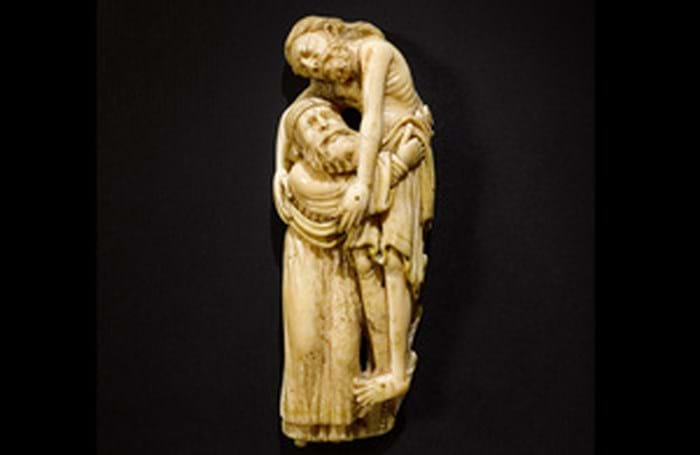
The Crucifixion with the Virgin, Saint John the Baptist and the Magdalen at the Foot of the Cross by Fra Angelico.
A panel by Renaissance artist Fra Angelico which sold at Christie’s in July 2023 has been blocked for export, as has a 12th-century English walrus ivory carving depicting the Deposition from the Cross following what is believed to have been a private sale via Sotheby’s to The Metropolitan Museum of Art.
The Fra Angelico panel, originally the centre of a devotional triptych commissioned by an unknown patron, was hammered down for £4.1m at Christie’s in London on July 6. It was a record for the influential early Florentine Renaissance master.
Born as Guido di Piero (c.1395/1400-1455), the artist became a Dominican friar in the small town of Fiesole outside Florence and adopted the name Fra Giovanni da Fiesole. Posthumously he became known as Fra Angelico or ‘Beato Angelico’ (Blessed Angelic One) and in 1982 Pope John Paul II proclaimed his beatification.
The 15th-century painting, The Crucifixion with the Virgin, Saint John the Evangelist and the Magdalen, is thought to have been acquired by the 2nd Lord Ashburton who died in 1864 and had subsequently passed by descent in the UK until the auction. The successful bidder has requested to take the panel overseas and the Department for Culture, Media and Sport has delayed the export licence giving a UK museum a chance to match the price.
The required amount is just over £5m (the hammer price plus fees) plus VAT of £180,200 which can be reclaimed by an eligible institution.
Museums have until April 7 to make an offer.
The arts and heritage minister’s decision to not grant a licence follows the advice of the Reviewing Committee on the Export of Works of Art and Objects of Cultural Interest (RCEWA).
Committee member Christopher Baker said: “Fra Angelico was one of the great innovators in the evolution of early 15th-century Florentine art. It is an extraordinary rarity that assists with our understanding of a formative period in the artist’s career and in the development of Italian Renaissance painting more widely.
“It has been in Britain since the early 19th century. It would constitute a major addition to a UK public collection and every effort should be made if possible to acquire it.”
Separately, a temporary export bar has been placed on a walrus ivory carving of the Deposition from the Cross.
The Romanesque carving, which is valued at £2,006,595 (plus VAT of £40,131.90), is made of walrus ivory and depicts the moment in the story of the Passion of Christ known as the Deposition from the Cross, in which Jesus’s body is lifted down from the cross by Joseph of Arimathea. It would once have been part of a larger scene and would have included a cross which is still partly visible and other figures. It dates to c.1190-1200 and could have been made in York.
On loan
According to media reports, the carving came from the collection of John Hunt (1900-75) and Gertrude Hunt (1903-95) and had been on loan to the V&A before it was sold in a private sale to the Metropolitan Museum of Art. The decision could mean the V&A will plan to raise funds to buy it, thwarting the Met’s purchase.
The arts and heritage minister’s decision follows the advice of the RCEWA.
Committee Member Tim Pestell said: “This rarity means we have much to learn from it, ranging from examining its artistic design and the workshop that produced it, to scientific investigation of the walrus ivory it is made of that might tell us about medieval exploitation of the environment, and trade and exchange networks.”
A UK institution has until February 2 to make an offer.






